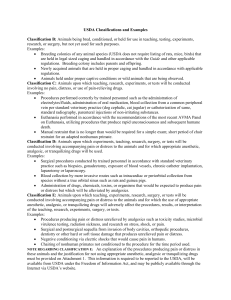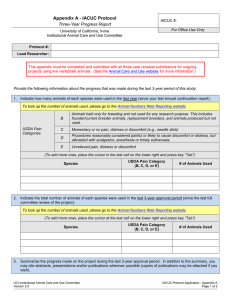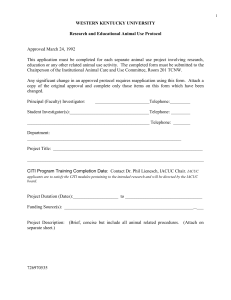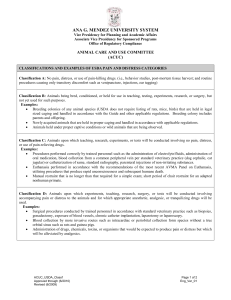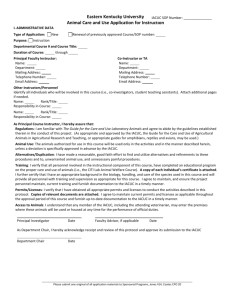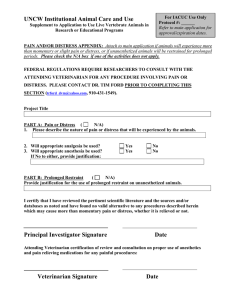Procedure Involving Pain or Distress to Animals
advertisement
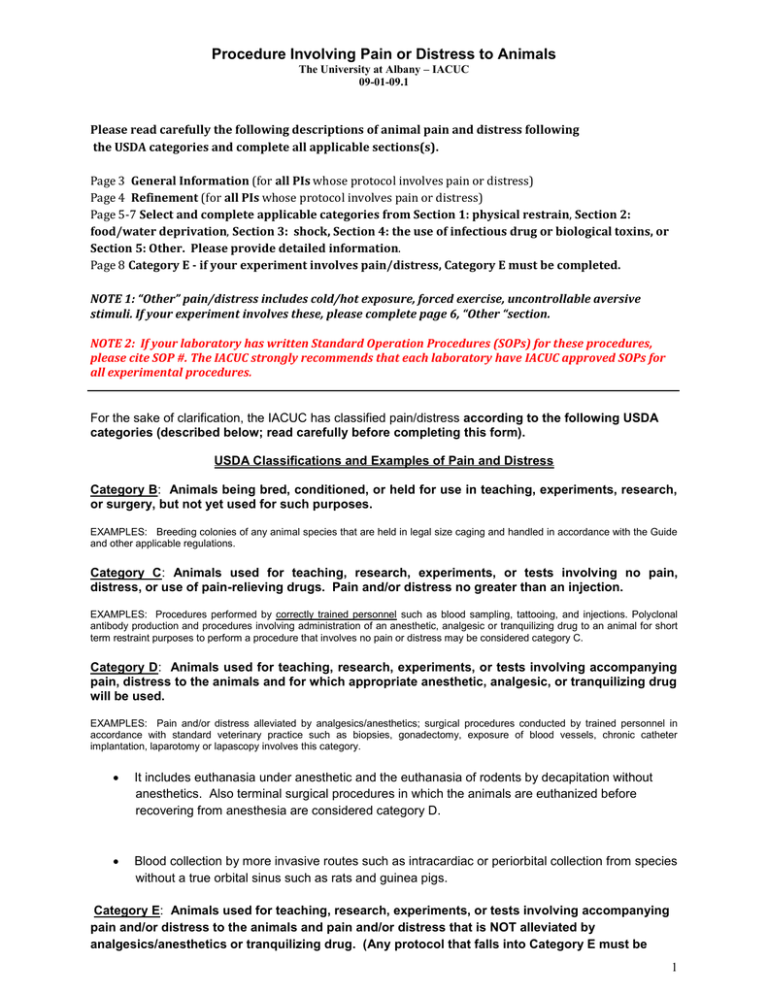
Procedure Involving Pain or Distress to Animals The University at Albany – IACUC 09-01-09.1 Please read carefully the following descriptions of animal pain and distress following the USDA categories and complete all applicable sections(s). Page 3 General Information (for all PIs whose protocol involves pain or distress) Page 4 Refinement (for all PIs whose protocol involves pain or distress) Page 5-7 Select and complete applicable categories from Section 1: physical restrain, Section 2: food/water deprivation, Section 3: shock, Section 4: the use of infectious drug or biological toxins, or Section 5: Other. Please provide detailed information. Page 8 Category E - if your experiment involves pain/distress, Category E must be completed. NOTE 1: “Other” pain/distress includes cold/hot exposure, forced exercise, uncontrollable aversive stimuli. If your experiment involves these, please complete page 6, “Other “section. NOTE 2: If your laboratory has written Standard Operation Procedures (SOPs) for these procedures, please cite SOP #. The IACUC strongly recommends that each laboratory have IACUC approved SOPs for all experimental procedures. For the sake of clarification, the IACUC has classified pain/distress according to the following USDA categories (described below; read carefully before completing this form). USDA Classifications and Examples of Pain and Distress Category B: Animals being bred, conditioned, or held for use in teaching, experiments, research, or surgery, but not yet used for such purposes. EXAMPLES: Breeding colonies of any animal species that are held in legal size caging and handled in accordance with the Guide and other applicable regulations. Category C: Animals used for teaching, research, experiments, or tests involving no pain, distress, or use of pain-relieving drugs. Pain and/or distress no greater than an injection. EXAMPLES: Procedures performed by correctly trained personnel such as blood sampling, tattooing, and injections. Polyclonal antibody production and procedures involving administration of an anesthetic, analgesic or tranquilizing drug to an animal for short term restraint purposes to perform a procedure that involves no pain or distress may be considered category C. Category D: Animals used for teaching, research, experiments, or tests involving accompanying pain, distress to the animals and for which appropriate anesthetic, analgesic, or tranquilizing drug will be used. EXAMPLES: Pain and/or distress alleviated by analgesics/anesthetics; surgical procedures conducted by trained personnel in accordance with standard veterinary practice such as biopsies, gonadectomy, exposure of blood vessels, chronic catheter implantation, laparotomy or lapascopy involves this category. It includes euthanasia under anesthetic and the euthanasia of rodents by decapitation without anesthetics. Also terminal surgical procedures in which the animals are euthanized before recovering from anesthesia are considered category D. Blood collection by more invasive routes such as intracardiac or periorbital collection from species without a true orbital sinus such as rats and guinea pigs. Category E: Animals used for teaching, research, experiments, or tests involving accompanying pain and/or distress to the animals and pain and/or distress that is NOT alleviated by analgesics/anesthetics or tranquilizing drug. (Any protocol that falls into Category E must be 1 accompanied by a written rationale justifying the need and value of such a procedure). EXAMPLES: Procedures producing pain or distress unrelieved by analgesics such as toxicity studies, microbial virulence testing, radiation sickness, and research on stress, shock, pain. Surgical and post-surgical sequels from invasion of body cavities, orthopedic procedures, dentistry or other hard or soft tissue damage that causes unrelieved pain or distress. - Link* USDA Pain and Distress website: http://awic.nal.usda.gov/nal_display/index.php?info_center=3&tax_level=1&tax_subject=310 * “Policy 11”: http://www.aphis.usda.gov/animal_welfare/downloads/policy/policy11.pdf * “Policy 12”: http://www.aphis.usda.gov/animal_welfare/downloads/policy/policy12.pdf * USDA Animal Welfare Act: http://www.nal.usda.gov/awic/legislat/usdaleg1.htm * Guide for the Care and Use of Laboratory Animals (p11-12, p60-64, p79, p64): http://www.nap.edu/openbook.php?record_id=5140 NOTE REGARDING CLASSIFICATION E: An explanation of the procedures producing pain and/or distress in these animals and the justification for not using appropriate anesthetic, analgesic or tranquilizing drugs must be provided on the Category 6 form. This information is required to be reported to the USDA and will be available from the USDA under the Freedom of Information Act, and may be publicly available through the Internet via USDA’s website. 2 SUPPLEMENTAL FORM 3 Procedure Involving Pain or Distress to Animals The University at Albany – IACUC 09-01-09.1 ORRC use only Protocol # [Note] PI NAME GENERAL INFORMATION 1. Indicate the USDA pain/distress category to which animals/species are assigned: Category C Category D Category E (→skip other sections and go to page 3) 2. Indicate criteria of pain/distress: Restrain Food/water deprivation Shock Other Provide a detailed description of the procedure(s) to be conducted: If you have IACUC approved SOPs, provide SOP # and skip purpose and procedure section. 3. List the criteria that will be used to determine the time point (s) to be used to terminate experiments that induce chronic disease or pain/distress. 4. Enter the complete name of the person(s) that will be performing experiment. For each, indicate the type and amount of previous experience related to pain/distress procedures. Name Training and Experience 1 Fill out applicable section: Section 1 for Restrain, Section 2 for food/water deprivation, Section 3 for Shock and other stress or pain for Section 4. ** If your laboratory has written Standard Operation Procedures (SOPs) for these procedures, please cite SOP #. The IACUC strongly recommends that each laboratory have IACUC approved SOPs for all experimental procedures. ** Section 1: Restrain 1. 2. YES NO Does your lab have IACUC approved SOPs for this procedure? If “yes”, provide SOP number: YES NO Will animal(s) be restrained for a period of one hour or more? 3. Describe the restraining device. 4. How frequently will animals be monitored per restraint period? 5. How frequently will animals be monitored post-restraint period? 6. Explain the reasons for restraining the animals for periods with scientific justification. 7. Provide contact information for those persons responsible for monitoring animals during the experimental period (pre-, post- restrain). Section 2: Food / Water Deprivation 1. YES NO Does your lab have IACUC approved SOPs for this procedure? If “yes”, provide SOP number: 2. YES NO Will animals be fasted or placed on a limited diet? If YES, answer following questions: - How long will animals be fasted or placed on a limited diet? - What criteria will you use to determine if animals are suffering as a result of the fast or restricted diet? 3. YES NO Will water be withheld from the animals? If YES, answer following questions: - How long will water be withheld? - What criteria will you use to determine if animals are suffering as a result of the water restrictions? 4. Explain the reasons for depriving food/water with scientific justification. 5. How frequently will animals be monitored during the deprivation (i.e. per day, per hour etc)? 6. Provide contact information for those persons responsible for monitoring animals during the deprivation and experimental period (include pre-, post- deprivation) 2 Section 3: Shock 1. YES NO Does your lab have IACUC approved SOPs for this procedure? If “yes”, provide SOP number: 2. Provide detailed information of shock that animals will receive (criteria, amount, frequency, length to received shock, description of shock etc). 3. Describe the restraining device. 4. How frequently/long will animals be monitored during the experimental period? 5. How frequently/long will animals be monitored after the experiment (after the shock) period? 6. Explain the reasons for utilizing the shock to animals with scientific justification. 7. Provide contact information for those persons responsible for monitoring animals during the experimental period (pre-, post- shock) Section 4: Other If more than “momentary” pain/distress (besides restraint, food/water deprivation, shock, or administration of infectious agents or biological toxins) is involved, please provide following information. (Other sources of pain and distress to consider: forced exercise(s), cold/hot exposure, uncontrollable aversive stimuli etc.) 1. YES NO Does your lab have IACUC approved SOPs for this procedure? If “yes”, provide SOP number: 2. Provide detailed information of pain/distress. 3. Describe the pain/stress device (if applicable). 4. Describe the administration, schedule, and the duration of the pain/distress source. 5. How frequently/long will animals be monitored during the experimental period? 6. How frequently/long will animals be monitored after the experimental (after exposure of pain/distress source) period? 7. Explain the reasons for utilizing the specific pain/distress source to animals with scientific justification. 8. Provide contact information for those persons responsible for monitoring animals during the experimental period (pre-, post- shock) 3 Category E Form This form is intended as an aid to completing ONLY the Category E explanation (when required). This form must be written so as to be understood by laypersons as well as scientists. NOTE: An explanation of procedures producing pain or distress in these animals and the justification for NOT using appropriate anesthetic, analgesic, or tranquilizing drug MUST be provided below. This information is required to be reported to the USDA when USDA covered species are being used and will be available from USDA under the “Freedom of Information Act (FOIA)”. The FOIA may make this information publicly available through the Internet via USDA’s Website. 1. Provide animal information. Species: Age: Sex: Numbers of animals: 2. Provide detailed information of pain/distress procedure without the use of appropriate anesthetic, analgesic, or tranquilizing drug: 3. Provide scientific justification why pain/distress could not be relieved. State methods or means used to determine that pain/distress relief would interfere with test results (supporting literature citations are recommended; attach a copy of citation article(s) 4
